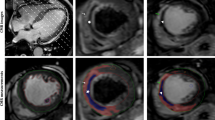Abstract
Background: Stenting has been shown to improve lumen diameters and thereby improve epicardial blood flow, but the impact of stent placement on tissue level perfusion has not been well characterized. Methods: Data were drawn from the LIMIT trial of rhuMAb CD18 (anti WBC antibody) in acute myocardial infarction (AMI). Adjunctive/rescue stenting was performed at the discretion of the investigator. The TIMI Myocardial Perfusion Grade (TMPG) was assessed and digital subtraction angiography (DSA) was used to quantify brightness of the myocardial blush. Results: TIMI 3 flow was 54.2% (64/118) before stent placement, and improved to 87.2% (102/117, p < 0.001) following stent placement. Likewise, Corrected TIMI Frame Counts (CTFCs) improved from medians of 37.6 to 21 (p < 0.001). By DSA, the rate of growth in brightness also tended to be greater after stenting (2.3 ± 0.4 Gray/sec, n = 54 vs 3.1 ± 0.3, n = 54, p = 0.07). The incidence of TMPG 0 decreased following stent placement (25.2% (29/118) vs 14.3% (16/118), p = 0.03) and the incidence of a stain in the myocardium (TMPG 1) increased (13.5% (16/118) vs 28.6% (34/118), p = 0.004). Conclusion: Adjunctive stenting following thrombolytic administration in AMI improves epicardial TIMI 3 flow and TIMI frame counts as well as dye inflow into the myocardium: TMPG 0 is reduced and myocardial blush measured quantitatively by DSA tends to be brighter. However, more TMPG 1 or dye staining was present on next injection, suggesting dye outflow may be impaired.
Similar content being viewed by others
References
The GUSTO Angiographic Investigators. The effects of tissue plasminogen activator, streptokinase, or both on coronary artery patency, ventricular function, and survival after acute myocardial infarction. N Engl J Med 1993;329:1615–1622.
Vogt A, von Essen R, Tebbe U, Feuerer W, Appel KF, Neuhaus KL. Impact of early perfusion status of the infarct-related artery on short-term mortality after throm-bolysis for acute myocardial infarction: retrospective analysis of four German multicenter studies. J AmColl Cardiol1993;21:1391–1395.
Karagounis L, Sorensen SG, Menlove RL, Moreno F, Anderson JL, for the TEAM-2 Investigators. Does Thrombolysis in Myocardial Infarction (TIMI) perfusion grade 2 represent a mostly patent artery or a mostly occluded artery? Enzymatic and electrocardiographic evidence from the TEAM-2 study. J Am Coll Cardiol1992;19:1–10.
Anderson JL, Karagounis LA, Becker LC, Sorensen SG, Menlove RL, for the TEAM-3 Investigators. TIMI perfusion grade 3 but not grade 2 results in improved outcome after thrombolysis for myocardial infarction. Ventriculographic, enzymatic, and electrocardiographic evidence from the TEAM-3 study. Circulation1993;87: 1829–1839.
Gibson CM, Cannon CP, Daley WL, et al. The TIMI Frame Count: a quantitative method of assessing coronary artery flow. Circulation1996;93:879–888.
Gibson CM, Murphy SA, Rizzo MJ, et al. The relationship between the TIMI Frame Count and clinical outcomes after thrombolytic administration. Circulation1999;99:1945–1950.
Gibson CM, Cannon CP, Murphy SA, et al., for the TIMI Study Group. The relationship of the TIMI Myocardial Per-fusion Grade to mortality following thrombolytic administration. Circulation2000;101:125–130.
Baran KW, Nguyen M, McKendall GR, et al., for the LIMIT AMI Investigators. A double-blind, randomized trial of an anti-CD18 antibody in conjunction with rtPA for acute myocardial infarction: the LIMIT AMI Study. Circulation104:2778–2783.
Gibson CM, Cohen D, Cohen E, et al., for the ESPRIT study Group. Treatment with Eptifibatide and Coronary Flow Reserve (CFR) Following Elective Stent Placement: an ESPRIT Substudy. Am J Cardiol2001;87(11):1293–1295.
Gibbons RJ, Miller TD, Christian TF. Infarct size mea-sured by single photon emission computed tomographic imaging with (99m)Tc-sestamibi: a measure of the efficacy of therapy in acute myocardial infarction. Circulation2000;101:101–108.
Gibson CM, Murphy SA, Barron HV, Cannon CP. Relation of epicardial blood flow and myocardial perfusion to long term outcomes 2 years following thrombolysis in acute MI: a TIMI 10B substudy. Circulation2000;102:II–435.
Gibson CM. The time-dependent open vascular hypothesis. Cardiology Rounds2000;4(10).
Harnek J, Zoucas E, Carlemalm E, Cwikiel W. Differences in endothelial injury after balloon angioplasty, insertion of balloon-expanded stents or release of self-expanding stents: an electron microscopic experimental study. Cardiovasc Intervent Radiol1999;22:56–61.
Yamazaki T, Komuro I, Kudoh S, et al. Endothelin-1 is involved in mechanical stress-induced cardiomyocyte hypertrophy. The Journal of Biological Chemistry1996;271:3221–3228.
Malliani A, Schwatrz PJ, Zanchetti A. A sympathetic reflex elicited by experimental coronary occlusion. Am J Physiol1969;217:703–709.
Brown AM, Malliani A. Spinal sympathetic reflexes initiated by coronary receptors. J Physiol (Lond)1971;212:685–705.
Heusch G, Deussen A, Thamer V. Cardiac sympathetic nerve activity and progressive vasoconstriction distal to coronary stenoses: feed-back aggravation on myocardial ischemia. J Auton Nerv Syst1985;13:311–326.
Gregorini L, Fajadet J, Robert G, Cassagneau B, Bernis M, Marco J. Coronary vasoconstriction after percutaneous transluminal coronary angioplasty is attenuated by anti-adrenergic agents. Circulation1994;90:895–907.
Gregorini L, Marco J, Kozakova M, et al. Alpha-adrenergic blockade improves recovery of myocardial perfusion and function after coronary stenting in patients with acute myocardial infarction. Circulation1999;99:482–490.
The TIMI Study Group. The Thrombolysis in Myocardial Infarction (TIMI) trial. N Engl J Med1985;312:932–936.
Gregorini L, Marco J, Palombo C, et al. Post ischemic LV dysfunction is abolished by alpha-adrenergic blockers. J Am Coll Cardiol1998;31:992–1001.
Mukherjee D, Moliterno DJ. Achieving tissue-level perfusion in the setting of acute myocardial infarction. Am J Cardiol2000;85:39C–46C.
Erbel R, Heusch G. Coronary microembolization—Its role in acute coronary syndromes and interventions. Herz1999:24:558–575.
Piana RN, Paik GY, Moscucci M, et al. Incidence and treatment of ‘No-reflow’ after percutaneous coronary intervention. Circulation1994;89(6):2514–2518.
Sakata Y, Kodama K, Komamura K, et al. Salutary effect of adjunctive intracoronary nicorandil administration on restoration of myocardial blood flow and functional improvement in patients with acute myocardial infarction. Am Heart J1997;133:616–621.
Ishihara M, Sato H, Tateishi H, et al. Attenuation of the no-reflow phenomenon after coronary angioplasty for acute myocardial infarction with intracoronary papverine. Am Heart J1996;132:959–963.
Olafsson B, Forman MB, Puett DW, et al. Reduction of reperfusion injury in the canine preparation by in-tracoronary adenosine: importance of the endothelium and the no-reflow phenomenon. Circulation1987;76:1135–1145.
Author information
Authors and Affiliations
Rights and permissions
About this article
Cite this article
Gibson, C.M., Frisch, D., Murphy, S.A. et al. The Relationship of Intracoronary Stent Placement Following Thrombolytic Therapy to Tissue Level Perfusion. J Thromb Thrombolysis 13, 63–68 (2002). https://doi.org/10.1023/A:1016253028348
Issue Date:
DOI: https://doi.org/10.1023/A:1016253028348




